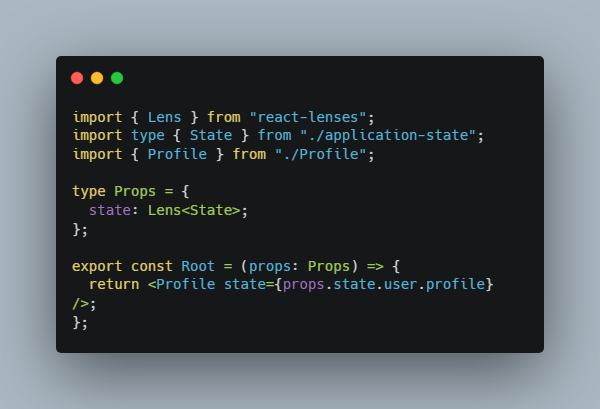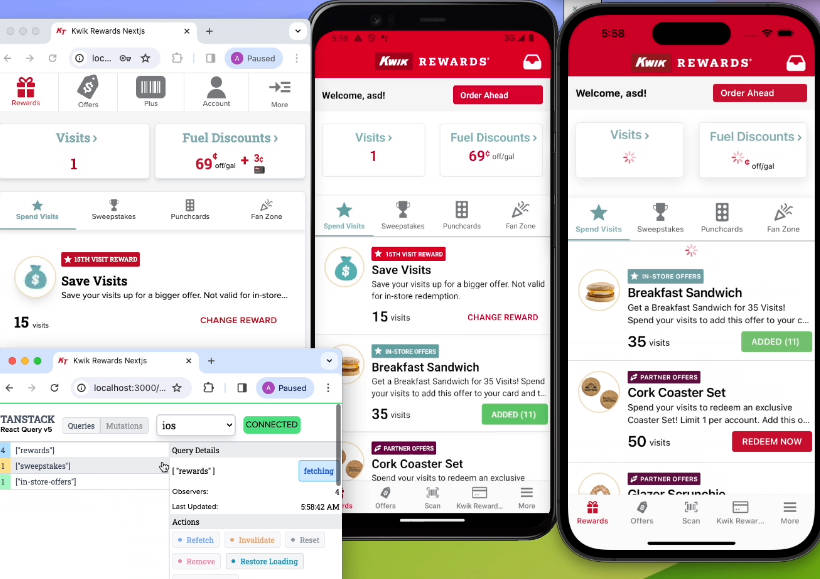npm i valtio makes proxy-state simple
Wrap your state object
Valtio turns the object you pass it into a self-aware proxy.
import { proxy, useSnapshot } from 'valtio'
const state = proxy({ count: 0, text: 'hello' })
Mutate from anywhere
You can make changes to it in the same way you would to a normal js-object.
setInterval(() => {
++state.count
}, 1000)
React via useSnapshot
Create a local snapshot that catches changes. Rule of thumb: read from snapshots, mutate the source. The component will only re-render when the parts of the state you access have changed, it is render-optimized.
// This will re-render on `state.count` change but not on `state.text` change
function Counter() {
const snap = useSnapshot(state)
return (
<div>
{snap.count}
<button onClick={() => ++state.count}>+1</button>
</div>
)
}
Note: useSnapshot returns a new proxy for render optimization.
Internally, useSnapshot calls snapshot in valtio/vanilla,
and wraps the snapshot object with another proxy to detect property access.
This feature is based on proxy-compare.
Two kinds of proxies are used for different purposes:
proxy()fromvaltio/vanillais for mutation tracking or write tracking.createProxy()fromproxy-compareis for usage tracking or read tracking.
Use of `this` is for expert users.
Valtio tries best to handle this behavior
but it’s hard to understand without familiarity.
const state = proxy({ count: 0, inc() { ++this.count } })
state.inc() // `this` points to `state` and it works fine
const snap = useSnapshot(state)
snap.inc() // `this` points to `snap` and it doesn't work because snapshot is frozen
To avoid this pitfall, the recommended pattern is not to use this and prefer arrow function.
const state = proxy({ count: 0, inc: () => { ++state.count } })
If you are new to this, it’s highly recommended to use
eslint-plugin-valtio.
Subscribe from anywhere
You can access state outside of your components and subscribe to changes.
import { subscribe } from 'valtio'
// Suscribe to all state changes
const unsubscribe = subscribe(state, () => console.log('state has changed to', state))
// Unsubscribe by calling the result
unsubscribe()
You can also subscribe to a portion of state.
const state = proxy({ obj: { foo: 'bar' }, arr: ['hello'] })
subscribe(state.obj, () => console.log('state.obj has changed to', state.obj))
state.obj.foo = 'baz'
subscribe(state.arr, () => console.log('state.arr has changed to', state.arr))
state.arr.push('world')
To subscribe to a primitive value of state, consider subscribeKey in utils.
import { subscribeKey } from 'valtio/utils'
const state = proxy({ count: 0, text: 'hello' })
subscribeKey(state, 'count', (v) => console.log('state.count has changed to', v))
There is another util watch which might be convenient in some cases.
import { watch } from 'valtio/utils'
const state = proxy({ count: 0 })
const stop = watch((get) => {
console.log('state has changed to', get(state)) // auto-subscribe on use
})
Suspend your components
Valtio supports React-suspense and will throw promises that you access within a components render function. This eliminates all the async back-and-forth, you can access your data directly while the parent is responsible for fallback state and error handling.
const state = proxy({ post: fetch(url).then((res) => res.json()) })
function Post() {
const snap = useSnapshot(state)
return <div>{snap.post.title}</div>
}
function App() {
return (
<Suspense fallback={<span>waiting...</span>}>
<Post />
</Suspense>
)
}
Holding objects in state without tracking them
This may be useful if you have large, nested objects with accessors that you don’t want to proxy. ref allows you to keep these objects inside the state model.
See #61 and #178 for more information.
import { proxy, ref } from 'valtio'
const state = proxy({
count: 0,
dom: ref(document.body),
})
Update transiently (for often occuring state-changes)
You can read state in a component without causing re-render.
function Foo() {
const { count, text } = state
// ...
Or, you can have more control with subscribing in useEffect.
function Foo() {
const total = useRef(0)
useEffect(() => subscribe(state.arr, () => {
total.current = state.arr.reduce((p, c) => p + c)
}), [state.obj])
// ...
Update synchronously
By default, state mutations are batched before triggering re-render.
Sometimes, we want to disable the batching.
The known use case of this is <input> #270.
function TextBox() {
const snap = useSnapshot(state, { sync: true })
return <input value={snap.text} onChange={(e) => (state.text = e.target.value)} />
}
Dev tools
You can use Redux DevTools Extension for plain objects and arrays.
import { devtools } from 'valtio/utils'
const state = proxy({ count: 0, text: 'hello' })
const unsub = devtools(state, 'state name')
Use it vanilla
Valtio is not tied to React, you can use it in vanilla-js.
import { proxy, subscribe, snapshot } from 'valtio/vanilla'
const state = proxy({ count: 0, text: 'hello' })
subscribe(state, () => {
console.log('state is mutated')
const obj = snapshot(state) // A snapshot is an immutable object
})
useProxy macro
We have a convenient macro with
babel-plugin-macros.
import { useProxy } from 'valtio/macro'
const Component = () => {
useProxy(state)
return (
<div>
{state.count}
<button onClick={() => ++state.count}>+1</button>
</div>
)
}
// the code above becomes the code below.
import { useSnapshot } from 'valtio'
const Component = () => {
const snap = useSnapshot(state)
return (
<div>
{snap.count}
<button onClick={() => ++state.count}>+1</button>
</div>
)
}
derive util
You can subscribe to some proxies and create a derived proxy.
import { derive } from 'valtio/utils'
// create a base proxy
const state = proxy({
count: 1,
})
// create a derived proxy
const derived = derive({
doubled: (get) => get(state).count * 2,
})
// alternatively, attach derived properties to an existing proxy
derive({
tripled: (get) => get(state).count * 3,
}, {
proxy: state,
})
proxyWithComputed util
You can have computed values with dependency tracking with property access.
Dependency tracking in proxyWithComputed conflicts with the work in useSnapshot.
React users should prefer using derive.
proxyWithComputed works well for some edge cases and for vanilla-js users.
import { proxyWithComputed } from 'valtio/utils'
const state = proxyWithComputed({
count: 1,
}, {
doubled: snap => snap.count * 2
})
// Computed values accept custom setters too:
const state2 = proxyWithComputed({
firstName: 'Alec',
lastName: 'Baldwin'
}, {
fullName: {
get: (snap) => snap.firstName + ' ' + snap.lastName,
set: (state, newValue) => { [state.firstName, state.lastName] = newValue.split(' ') },
}
})
// if you want a computed value to derive from another computed, you must declare the dependency first:
const state = proxyWithComputed({
count: 1,
}, {
doubled: snap => snap.count * 2,
quadrupled: snap => snap.doubled * 2
})
The last use case fails to infer types in TypeScript
#192.
proxyWithHistory util
This is a utility function to create a proxy with snapshot history.
import { proxyWithHistory } from 'valtio/utils'
const state = proxyWithHistory({ count: 0 })
console.log(state.value) // ---> { count: 0 }
state.value.count += 1
console.log(state.value) // ---> { count: 1 }
state.undo()
console.log(state.value) // ---> { count: 0 }
state.redo()
console.log(state.value) // ---> { count: 1 }
Plugins
Recipes
Valtio is unopinionated about best practices.
The community is working on recipes on wiki pages.
- How to organize actions
- How to persist states
- How to use with context
- How to split and compose states





